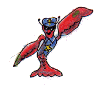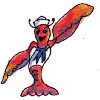
Here the cast will entertain you with some antics and if you are not careful
you may learn something.
 Rocko
will cover some of the laws surrounding Lobsters
Rocko
will cover some of the laws surrounding Lobsters
- Minimum Size. Lobsters have to a minimum size before they
can be taken from the ocean. The Department of Fisheries sets size limit, to
ensure they all measure the lobster the same way. Lobsters are measured from
the just behind the eye to the end of the abdomen. The measuring gauge must
touch the lobsters abdomen. The lobster has to be thrown back if the gauge
goes past the end of the abdomen. Regulations require that wholes in the
trap be a sized to allow small lobsters to escape (The remaining lobsters
still have to be measured).
- Protecting the Next Generation. Female lobsters carry
eggs underneath their tail. Any female lobster caught carrying eggs has to
be thrown back. The female lobster will drop the eggs once they have
matured.
- Licenses. Each commercial lobsterman needs to have a
shellfishing license issued from the department. The license allows the
fisherman to drop traps in the ocean. The license for lobsterman is visible
on the buoy used to mark their traps. The terms of the license also allows
the boat to be boarded at any time by the Department of Fisheries (DOF) to
inspect the lobsters for size and egg violations.
 Crusher
wants to tell you about his physical strength.
Crusher
wants to tell you about his physical strength.
- Bulging Biceps. Crusher has two large claws that he can
use to capture prey. He has a quick slashing pincher claw and large
'crushing' claw. Lobsters will use the pincher to grab prey and bring it
close enough to get a hold of with the crusher. Once in the crusher there
little chance for escape. A lobster can easily snap a pencil or even a
finger once in the grasp of the crusher. Lobsters can be either right or
left handed. Some lobsters have the crushing claw on the right while others
have it on the left. Crusher's large claw is on the left. Does that make
him right or left handed?
- External Skeleton. Lobsters have an external skeleton.
This gives them extra protection from predators and each other. This also
means that in order to grow they must molt. Twice each season the lobster
discards his old shell and grows a new one. The lobster is very vulnerable
during this time. His external skeleton takes a couple of weeks to harden.
During the time they will usually hide under a rock and try to stay out of
harms way.
- Which way am I going? Lobsters use their legs to slowly
move forward. They crawl across the bottom looking for food. But, when they
need a quick burst of speed they are great swimmers. There is only problem
with swimming. They have to travel backwards. They quickly close their tail
to propel them throw the water like a jet. This gives them a good view of
what they are running away from but they have no idea where they are headed.
 Salty
will tell you a little about his environment
Salty
will tell you a little about his environment
- At home in The Maritimes. While salty has been all over
the world he is most comfortable in Maritime waters. Rock lobsters are cold
water creatures. The lobsters you see in warm water areas like the Caribbean
are not rock lobsters. They are called spiny lobsters. Spiny lobsters do not
have the large front claws like their northern cousins (and they are not
very good dancers)
- In The dark. Lobsters are usually nocturnal. They keep a
low profile during the day and usually hide under a rock. During the night
they come out and roam the ocean floor looking for food, and bare feet
walking on the beach.
 Murky
will give you a little history lesson.
Murky
will give you a little history lesson.
- Poverty Food?? Long ago, lobsters were so plentiful that
Native Americans used them to fertilize their fields and to bait their hooks
for fishing. In colonial times, lobsters were considered "poverty
food." They were harvested from tidal pools and served to children, to
prisoners, and to indentured servants, who exchanged their passage to North
America for seven years of service to their sponsors. In Massachusetts, some
of the servants finally rebelled. They had it put into their contracts that
they would not be forced to eat lobster more than three times a week.
- Now A delicacy. During World War II lobster was
considered a delicacy, and consequently was not rationed. Thus lobster meat
filled the increasing demand for protein-rich food. People in the US could
afford it because of the boom of the war-time economy. Although there was a
decline in lobster purchases immediately after the war, lobster consumption
rapidly rebounded. In the years between 1950 and 1969, per capita lobster
consumption increased from .585 pounds (live weight) to .999 pounds. At the
same time the cost of lobster outpaced inflation, increasing profits for
lobstermen and thereby encouraging more people to join the industry.
 Junior
will give you a little miscellaneous information
Junior
will give you a little miscellaneous information
- Male or Female? There are a couple of things you can look
for to determine if a lobster is male or female. Female lobsters have wider
tails. This comes in handy for carrying around the enormous amount of eggs.
Male lobsters have thinner tails. They also have spikes on the underside of
their tails. Male lobsters also have larger upper bodies.
- When is 'in season'? Most restaurants vary the price of
lobster from season to season. This is because lobsters are more common
during certain parts of the year. Lobsters make two migrations each year. In
the Bay of Fundy area, they migrate up the bay in July to lay eggs. Lobsters
also make a second and smaller migration during the month of November.
During these migrations the lobsters are easily caught.